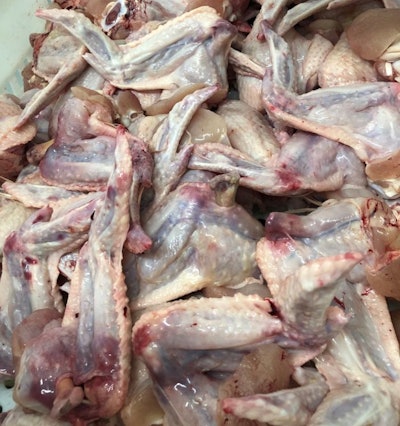
Wing defects, where did they come from? This question is as old as “Which came first, the chicken or the egg?" Today, the importance of live bird handling and processed carcass quality cannot be overstated as both influence a company's efficiency and profitability. When processing poultry, the two primary wing defects that must be considered are bruises and broken wings. This topic is interesting because both farm and plant operations can be involved in their origin.

Mike Casto, Processing Specialist on Cobb-Vantress' World Technical Support Team (Cobb Vantress)
Live operations
In the live broiler grow-out operations, there are instances that can cause overactivity and flightiness in birds that result in wing damage and defects. Violent wing flapping, crowding and piling may result in wing defects, especially as birds become larger and stronger. Birds become quite content with a steady lighting program. Therefore, abrupt movement by growers or technicians, adverse weather, or sudden increases in light intensity can cause the birds to react with heavy wing flapping and piling. Disruptions in the ad libitum provision of feed and water can also cause broilers to become stressed, resulting in increased densities near feed lines upon reintroduction of feed. Today’s broilers have a robust appetite for feed, and thus it is important to have feed readily available to optimize their growth and development while also keeping them calm and satisfied. To reduce stress and wing damage in a flock during an unexpected shortage in feed or water during the grow-out cycle, the following tips should be followed:
- Keep lights turned off, close windows, or keep light levels low so that birds will be calm until the feed and/or water has been restored.
- Minimize the entry of staff and essential visitors so that the flock distribution will remain normal.
- Maintain the appropriate temperature and ventilation in the house so that bird comfort is optimized.
Catching and transporting
The design for catching birds in broiler housing is typically the same in most parts of the world. In preparation, raise or remove all house equipment to allow personnel, machinery, coops, cages, forklifts and other equipment to flow in and out of a house, and prevent situations and conditions that can stress birds. Before collecting, stage birds in smaller groups to help avoid piling. Utilize tunnel fans and cool cells if available to avoid thermal stress. Place the modules or coops as close to the birds as possible. Monitor hand-catching crews for proper bird handling. Do not allow swinging of birds being carried. Ensure the birds are restrained by the feet or back and not carried by the head or wing. Establish a set number of birds (maximum per hand per person). When using automated catching machines, dark-out conditions are the most effective for keeping birds calm. Machines have loud engines, rotating fingers and conveyors that carry the birds to containers. If not well maintained or operated incorrectly, mechanical catching can cause more violent wing flapping, which can result in increased incidence of wing defects.
Monitor quantity (kilograms/pounds) per coop or module to avoid overcrowding. Remember, wing defects directly correlate with light management, bird handling and attention to detail by staff involved in catching birds and operating equipment. Ensure that your company has a maintenance program to repair or remove broken or defective containers. Bad road conditions increase the likelihood of defects. Ideally, drivers should avoid uneven terrain, potholes, sudden stops and irregular driving to minimize bird stress and wing damage during broiler transportation. Training and supervision are keys to good results.
Processing methods
Once at the processing facility, proper live bird unloading and shackling are critical to prevent wing bruises and broken wings. Whether you utilize dump cages, coops, drawers or other modules, it is important that the transfer from the container to the shackles is smooth and designed to prevent physical stress. With dump cages, birds are unloaded onto a series of transfer belts that carry the birds to the shackling area. Ensure these multiple transfers are not abrupt. Avoid large height variations between the conveyors since large drops can give birds the sensation they are free falling, resulting in vigorous wing flapping. Avoid large gaps between conveyors and repair broken or torn belting. Shacklers must follow best management practices. Ensure that both of the bird’s feet are completely at the bottom of the shackle. Birds should not be handled or shackled by the drumsticks as this can result in hock bruising. Harvest lines must utilize properly maintained shackles, guide bars and breast rubs to provide maximum bird calmness. Shackling areas should be darkened using blue, black or other types of lights that create a safe but dark environment.
Improper stunning techniques (over- or under-stunning) may also cause wing damage in the form of bruising, breakage or joint dislocation. An inconsistent stun occurs when conductivity is intermittent and current is reintroduced multiple times. This is the primary cause of damaged (blown) shoulders and has also been associated with bruising and blood splattering on the tenders and breast meat. The development of controlled atmosphere stunning negates the necessity for the dark shackling area as the birds are unconscious prior to shackling. Gas stunning (CO2 is most commonly used), if performed correctly, can also reduce the incidence of wing damage.
Wing defects: Where did they come from?
For companies to determine their wing defect origins, it is recommended to have a comprehensive evaluation program. Focus on three areas to investigate wing defects:
- Review birds upon arrival at the plant straight from modules before dumping or shackling.
- Birds suspended from the shackles should be evaluated after dumping, before stunning, after stunning and after birds exit the bleed-out area.
- We also suggest an evaluation of bird quality after feather removal (picking) since this may help the processing plant staff determine if wing damage is due to preharvest or postharvest procedures.
The information presented is best practices and must be used in the context of your own operations. As a processor, make your adjustments with outcome-based results aiming for quality, yield and customer satisfaction.














